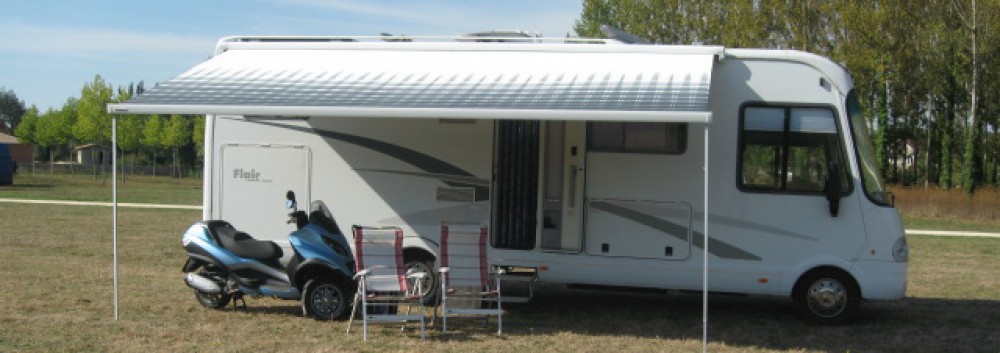We left home on 23rd August and headed down to Dover, crossing on the ferry and making our first night stop at Le Treport.
Le Treport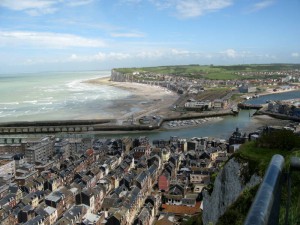
We had to be in St Malo by the 25th as we were meeting up with our family on that date. We hadn’t booked anywhere but hoped to be able to stay around St Malo for a few days as we had booked our son, daughter-in-law and granddaughter into a hotel on the seafront there. We arrived at a reasonable time but after looking around we were unable to find a suitable Aire to stay for a few days. We eventually stumbled on the municipal site at Saint-Servan-sur-Mer. This is a very nice location alongside the old fort with views over the bay to Dinard on one side and St Malo on the other.
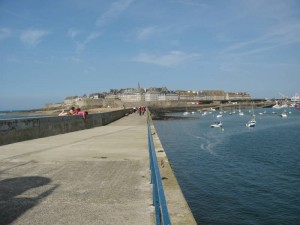 St Malo
St Malo
The only downside is that being a municipal site there is not much in the way of polish or structure. That said we enjoyed our stay and would go back again.
The following day we waited at the ferry port for our family to arrive having taken the overnight boat from Portsmouth. After seeing them booked into the hotel we spent the rest of the day touring around St Malo and playing on the beach with Greta. August is a good month for visiting St Malo as the place simply comes alive in the evenings with lots of side shows, suitcase traders, travelling performers, artists and children’s magicians.
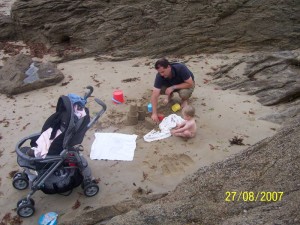 Making Sand Castles
Making Sand Castles
There are dozens of restaurants on the inside of the town walls, most offering seafood dishes, a favourite of our son and ourselves. It is possible when the tide is out to walk out to the small island on the north western edge of the town. The old submarine pens have been converted into a marina and fishing dock with the rest being used commercially. We spent 4 great days here just messing around, BBQ’ing, eating out in the restaurants, visiting the old Fort, walking along the coast path to the Rance Barrage.
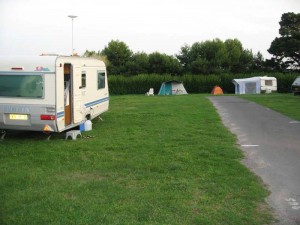 Site at St Servan-sur-Mer
Site at St Servan-sur-Mer
This all ended too quickly when our family had to board the boat for their return journey to Portsmouth.
From St Malo we headed south west to La Rochelle, a place we have visited many times over the years but this was the first time we had travelled by Motorhome. According to the books we had with us there are five or six Aires in and around La Rochelle, however one or two were full with private cars, others were simply full so we found one site by the river side on the opposite side to the town centre harbour.
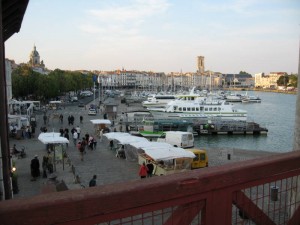 La Rochelle
La Rochelle
We stayed here for a couple of days before moving to an Aire on the northern outskirts of town that was better for Chase as it was restrictive for him being able to run around without his lead. We love La Rochelle and have a certain number of places that we visit each time in addition to seeking out new places. In a similar fashion to St Malo, La Rochelle comes alive at night and we spend hours walking along the harbour viewing the various artists and their work. The old town is great even in summer as there are stone arches along each street where shoppers can walk, browse and sightsee without getting overpowered by the sun.
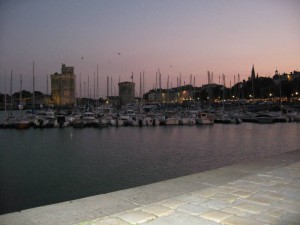 La Rochelle Harbour
La Rochelle Harbour
La Rochelle has the distinction of being one of the first places in France to fit electric charging points for the advent of electric vehicles. (not that we saw any charging points or electric vehicles)
On moving to the north of town it gave us the opportunity to cycle into town each day along the coastal cycle path achieving two goals – one – exercise for us and a quicker trip into the town centre – two – good exercise for Chase as he could run alongside us either on his springer or run free on the open parts.
After 5 days we decided to move on to the Dordogne area, a place we visited briefly several years ago. We started off by overnighting in a small village outside St Emillion, famous for its wines. It was a lovely spot, nestled in among the vines with a dedicated service point – it even had EHU for those that needed it.
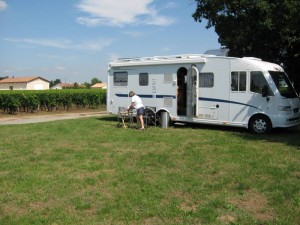 Vineyard at St Emillion
Vineyard at St Emillion
We walked around the village and was tempted to pick fresh figs that were hanging on the trees in the roads and fields around but decided against it as we didn’t want to get arrested or thrown into prison. We called at the vineyard on the way back to buy a bottle of wine to go with our BBQ but failed on a number of counts – one, they didn’t sell loose bottles, only cases of twelve. Two, the cases were over €100 each and thirdly – they didn’t take credit cards so we politely declined as we didn’t want to purchase €100 worth of wine we hadn’t tasted.
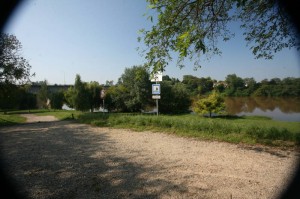 Aire at Bergerac
Aire at Bergerac
From here we sauntered along the river Dordogne making our next stop at Bergerac. Here we stayed a couple of nights giving us time to look around the town. We found the Aire right on the river bank, but close to the main road. Our first task was to find the Tourist Info Office then take the Petite
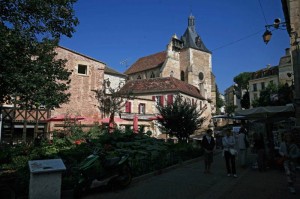 Town Centre – Bergerac
Town Centre – Bergerac
Train trip to orientate ourselves with the town and get an understanding of the places to see. Bergerac has many oldie world buildings, a beautiful bridge and several interesting architectural sights. The town square is a must see, as is the market.
Bergerac has two bridges, one is the original stone bridge and the other is a modern steel structure.
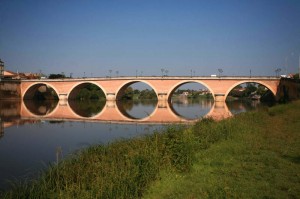 Old Bridge at Bergerac
Old Bridge at Bergerac
Near the old bridge is the wharf where the old barques used to bring timber, cork and other goods into and out of the town during the times when the Dordogne was navigable.
From here we moved along the Dordogne to the small town of Les Eyzies-de-Tayac. This place is famous for its houses that are carved out of the rock face. There are several villages in the region that are carved into the surrounding rocks. The Aire is one of the best in the region if not the country. It is located alongside the river with walks or cycle tracks on either side.
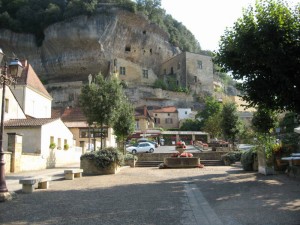 Les Eyzies-de-Tayac
Les Eyzies-de-Tayac
It is laid out into individual plots, each with its hedges, hard standing. There is a toilet block and shower block as well as a service point – all in local stone. During 2007 the cost was €3 per night. In the town/village there are museums of the troglodytes, a very helpful Tourist Office and a variety of shops, cafe’s and restaurants. This is a great place to use as a base for touring round the Dordogne region.
From here we moved on to Salat and Domme.
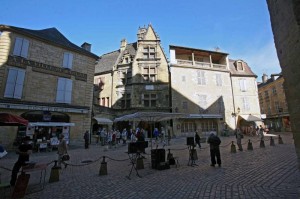 Sarlat
Sarlat
Two lovely towns that symbolise the old Dordogne region. Sarlat with its geese markets, where all the pate de fois gras comes from and Domme as a centre for the Crusaders back in ancient times when the Cathars were dominating the region to the south of the Dordogne.
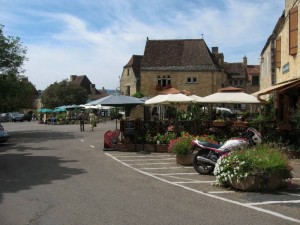 Domme
Domme
Domme is situated on the top of the hills that are either side of the Dordogne river. We stayed on the Aire at the rear of town at the foot of the town wall. You can walk up the road into the town or the Petite Train travels every 30 minutes from the Aire up into the town square.
From here we moved over to Padirac, an underground cave that is full of carvings and underground rivers etc. Sadly on the day we arrived the whole workforce was on strike so we were unable to visit this place. This is the second failure we have had here so if we fail once more it will be struck off the list for good.
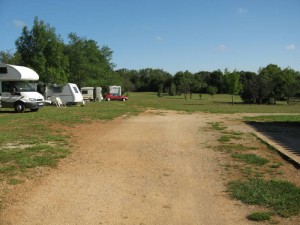 Campsite near Rocamadour
Campsite near Rocamadour
So we moved on to Rocamadour and stayed at the camping Blanche some 700 mtrs from the top of the road down into the Town. This was a good move as it turned out as we were equidistant from Hospitalet and Rocamadour. This gave us the opportunity to view Rocamadour from a distance at night and catch the town all lit up.
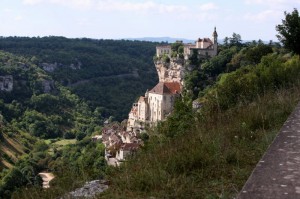 Rocamadour from Hospitalet
Rocamadour from Hospitalet
It is a good walk down into town and it was a hot day with many hundreds of steps to climb up and down. Still it was worth it.
Again we moved off this time calling at the Bretanoux Chateau – a well preserved chateau at the geographical end of the Dordogne region. We spent several hours looking round the place and took the guided tour around the inside private rooms of the chateau.
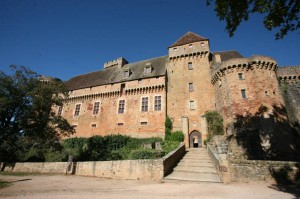 Bretanoux
Bretanoux
The colour of the stone was very striking and the whole place is kept in very good order. There are cafe’s and restaurants around the perimeter however we needed to move on if we were to reach our stop for the night at Clermont L’Herault. Clermont L’Herault was a stepping stone for our next real stop which was the Camargue.
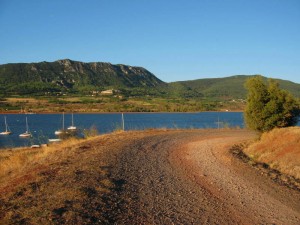 Clermont L’Herault
Clermont L’Herault
Here we wanted to see the wildlife and were looking forward to seeing the famous pink Flamingos. We were not disappointed. We first pulled into the Aire at Salins – a very run down place. We topped up with water, emptied our waste and WC cassette as we knew there would be no facilities where we were going. We had decided to stop on the wild camping beach at Pie Manson Plage.
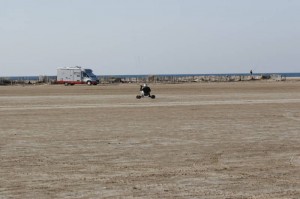 Pie Manson Plage
Pie Manson Plage
This place is some 10 kms alond a narrow road that leads through the salt marshes of the Camargue and ends up at the beach at Pie Manson. This is a beautiful expanse of some 400+ mtrs of clear sandy beach on one side with the Etangs of the Camargue on the other. There is a strip of solid beach separating the two sections that is so flat and hard that it would make a good alternative to the Utah salt flats and Bonneville.
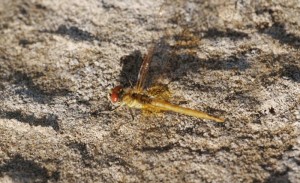 Dragon Fly – by the Thousand
Dragon Fly – by the Thousand
One creature we didn’t expect to see was the giant Dragon Fly – by the thousand. They were up to 4 inches in length and looked like minature helicoptors. There were hundreds of Flamingos. The beach was spectacular and the sea very warm.
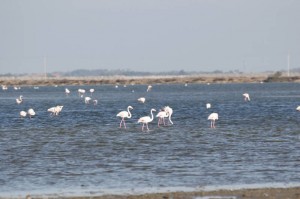 Pink Flamingos
Pink Flamingos
We spent a few days here just beach combing and relaxing in general with BBQ’s every night. Chase was able to run around free all day.
We now decided to move across the Camargue to a little piece of civilisation at Saints Maries de la Mer. The only real town on the sea front of the Camargue region. here we stayed on the Aire by the sea wall some 200 mtrs out from the main town centre. Sts Maries is a bustling town that enjoys Spanish bull fighting. There are numerous horse riding stables and the Etangs have strategic look out points to watch both the Flamingos and the Camargue wild horses.
By now we had only ten days to go before our return ferry to UK so started to head north along the Rhone valley.
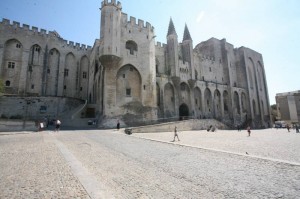 Pope’s Palace
Pope’s Palace
We spent our first stop at Avignon and decided to stay here a couple of days before detouring along the Ardeche valley and “see if it was worth coming back to see properly”. Avignon is one of those places that you need to come back to time after time as there is always something new to see. Again we decided to make use of the Petite Train to get an idea of what there is to see.
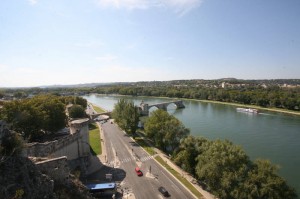 Pont D’Avignon
Pont D’Avignon
The train departs from the Pope’s Palace – a grand building just off the main square in a square of its own. We climbed up to the top of the ramparts, walked around to the famous Pont D’Avignon but were unable to walk on the bridge itself as they don’t allow dogs. Still we got a good view from the top of the river meandering its way south.
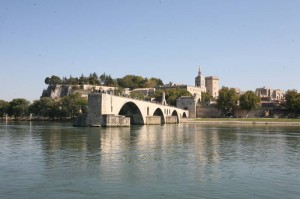 Pont D’Avignon from Island
Pont D’Avignon from Island
We stayed outside Avignon in the town of Veillenerve Avignon on the small campsite at the foot of the castle walls. In future we will stay on the Isle de Bardelasse overlooking the old walls of Avignon as it is both closer and cheaper than where we stayed this time.
Off we went again up the Rhone valley towards the Ardeche Valley. This detour didn’t add many miles onto our journey as we went in a loop coming out some 150 miles further up the Rhone valley just before Lyon.
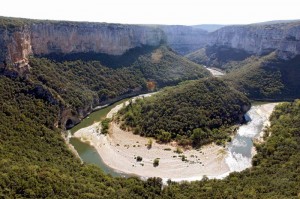 Ardeche Valley
Ardeche Valley
It took us all day to work our way up after stopping at view points along the route, stopping for coffee, lunch and a browse around the shops and ended up staying the night in the village of Aubinas – up in the mountains.
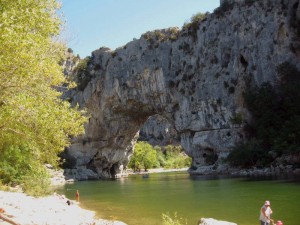 Relaxing in the Ardeche
Relaxing in the Ardeche
This was a good overnight stop as the Aire is positioned on a hill with a near 360 degree panarama.
Aubinas is a renovated village isloated among the Ardeche mountains. There are no shops, cafe’s or restaurants and the villagers rely on their own resources or go out down the valley to get food etc.
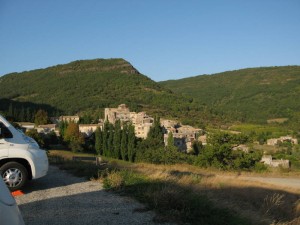 View of Aubinas
View of Aubinas
They provided the Aire as they wanted folks to visit their village to see how beautiful it is.
The next day we continued on our journey north and stopped for the night in the village of Prissey. This is a wine growing area and we were lucky to arrive there when they were harvesting. Even though they were obviously busy they made time to show us around the place, explaining how they made wine, how the grapes were graded and how each grower was assessed by the quality (sugar level) of their grapes.
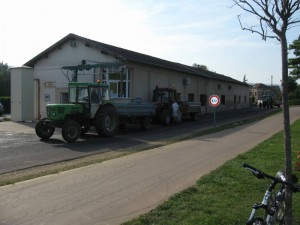 Grape Grading at Prissy
Grape Grading at Prissy
Our next stop was at the town of Mareuil-sur-Ay – another wine growing village, this time on the river Ay in the Champagne region of France. The town was awash with flowers and all the grass was neatly cut. On the downside it was very busy and we only just managed to find a place to stay.
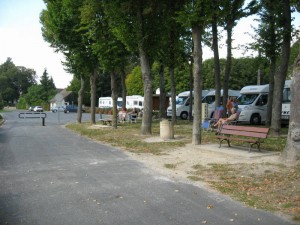 Mareuil-sur-Ay
Mareuil-sur-Ay
This was to be our last stop before reaching Calais where we needed to spend a day while Chase had his passport stamped. Once formalities and timescale had been completed we boarded the ferry for home. A very successful and pleasant holiday.
